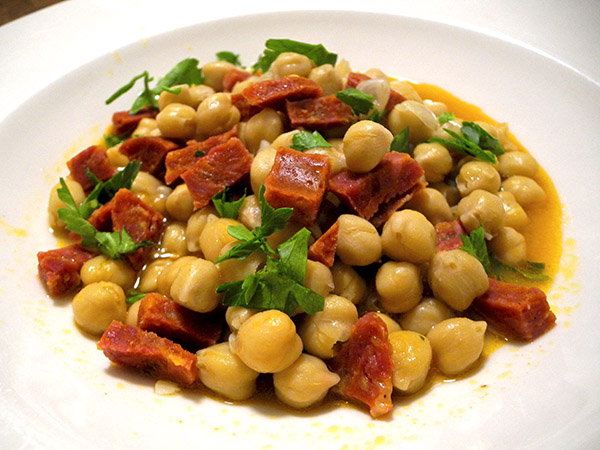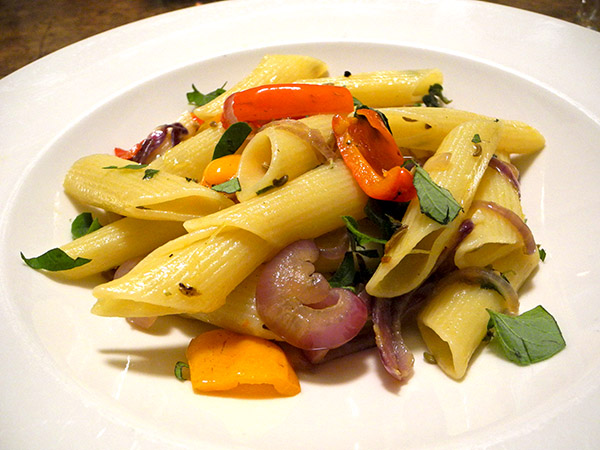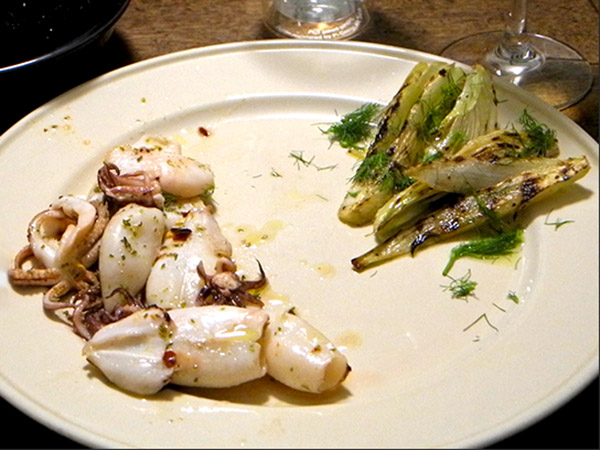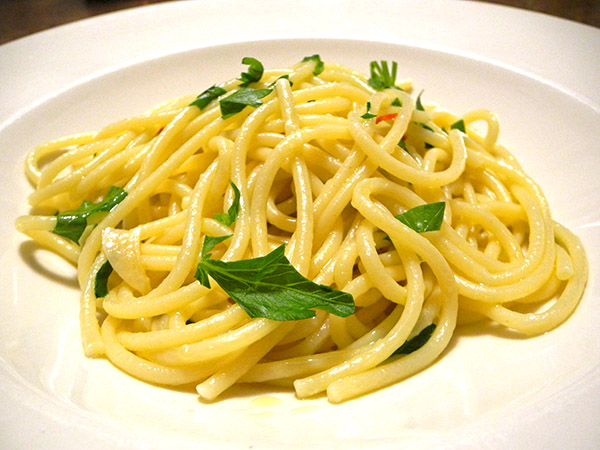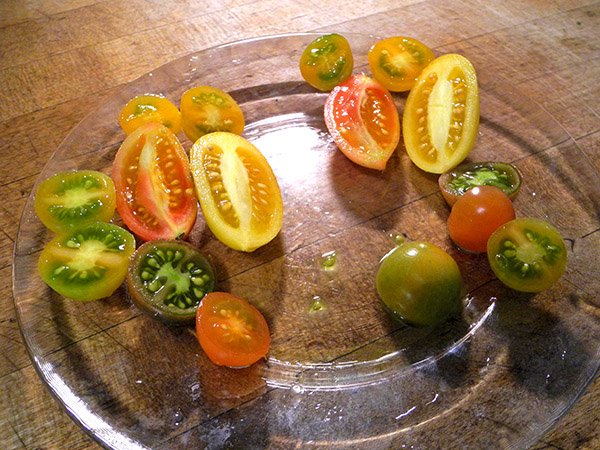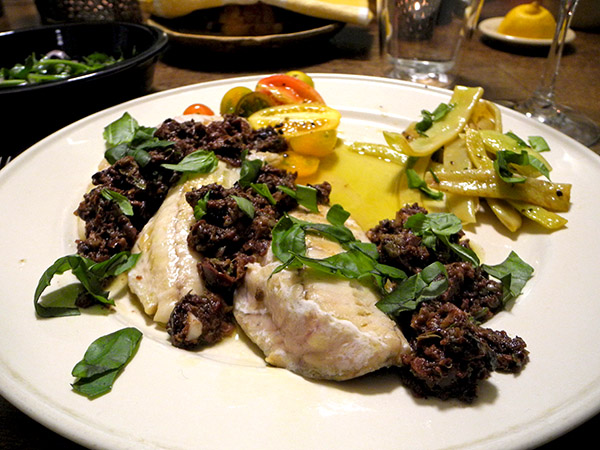
I had not realized, before I put it on the table, just how appropriate this dish would be for a day on which we had revisited the Donald Judd house.
To begin with, it’s probably the second most minimal recipe in my kitchen ‘kit’ (the first has got to be this spaghetti aglio olio e peperoncino). but beyond that, while the sections of pasta I always use start out as round tubes (a shape not much encountered in Judd’s work or his SoHo house, once they have been cooked they flatten almost completely, and equally seductive rectangles emerge. Although it may be something of a stretch, I imagine the shape as relating to Judd’s kit.
Every Italian bachelor, full-time or temporary, is alleged to know how to whip up one meal by himself, the dish of spaghetti with a simple sauce of garlic, oil and peppers I mention above. Maybe this simple tomato sauce (which incidentally goes with virtually any pasta) should be in the repertoire of every single girl (or homo), Italian or otherwise, since the recipe requires a little more lead time than the aglio olio e peperoncino, requiring advance planning most bachelors might not be up to.
The story of this dish begins with my visits to a West Village barber shop, beginning in the mid-eighties. But it wasn’t just any barber shop, as I learned over time.
Nick’s Hair Salon, which sadly no longer exists, was located at 5 Horatio St. It opened in 1956, fronting on the north sided of an extremely tiny (about 100 square feet) Greenstreets triangle bounded by Horatio, West 4th Street, and 8th Avenue. Once it had been ‘adopted’ and planted, I would often point out its rich greenery to visitors from less densely-populated realms, as “one of our parks”).
Nick Soccodato was a lovely, affable, and gentle man (with a great full head of hair).
He was a barber and had been a barber, he once told me, from the time he graduated from his first job, which he described as hanging around shops and sweeping up the hair on the floor (I don’t recall where he said that was, but it may have been the same location he eventually owned). Nick was also a dealer, a very special dealer. At some point in the history of his shop he began a second career, dealing in food, Italian food, specifically the vegetables and fruits associated with his family’s Italian bel paese, the Agro Nocerino , and most specifically, with the San Marzano tomato, which has been, and always will be, associated with the area.
I don’t know, but Nick and his Italian nephew, Savino Zuottolo, might have created the American market for San Marzano tomatoes almost on their own, in the back of the business that was later called, ‘Nick’s Hair Styling‘.
I had occasionally seen people come into the shop and walk out with packages, cans, and jars of Italian food, but I hadn’t thought much of it, probably marking it up as just another eccentricity of the owner and a staff not without such things. But one day I found myself talking to Nick about his family’s homeland. I told him how much I loved the Campania, on every level, and also told him that I loved cooking, generally using the simplest Italian dishes, and usually southern Italian, as my models.
For sharing my interest with him, I was rewarded with a tour of the barbershop’s back room, where cans, jars and packages of dry stuffs were stocked and displayed something like a much smaller version of the wonderful emporium, Buon Italia, in the Chelsea Market. I already knew that the various sized cans of San Marzano tomatoes were the stars, but my eyes really lit up when I spotted the packages of short sections of huge tubes of dried pasta. I thought their contents were absolutely, beautiful, and as perfectly minimal as a bunch of long spaghetti.
I had never seen anything like that pasta before, and I had to take some home. I had the wits to ask Nic what kind of sauce it would traditionally be served with. In his answer he described relaxed Sunday afternoon meals of a Paccheri with a simple tomato sauce using canned San Marzano plum tomatoes, and he promised he would ask his wife to copy her recipe and he would give it to me.
I, or rather, we, have dined like Barone ever since, regularly enjoying minimal feasts of paccheri served with Rose Soccodato’s simple San Marzano tomato sauce. I didn’t remember her name when I transcribed the instructions to my file, so the recipe has always been known as ‘Mrs Nick’s Simple Tomato Sauce’ in our kitchen.
I can’t recommend it enough, but please do not to try it with anything other than San Marzano tomatoes, although, as with so many food source questions, even with ‘Denominazione d’Origine Protetta (DOP)’ printed on the can, exactly what that means may not be perfectly clear.
THE RECIPE
In an enameled cast iron pot or other non-reactive pan, large enough to hold the pasta after it’s been cooked, sauté 2 or 3 cloves in 4 to 5 tablespoons of olive oil, but only until the garlic is pungent.
Add one 28-ounce can of San Marzano tomatoes (already-chopped or whole, and ideally without basil), crush the tomatoes with a wooden spoon if they are whole, sauté uncovered at high heat for 5 minutes, stirring a few times to reduce the liquid (yes, the juices will spatter a bit; I use a black apron and check the surrounding environment after this step).
Reduce the heat to very low, so the sauce is barely bubbling, add salt and freshly-ground pepper to taste, and simmer for a full 30 minutes.
Add a few whole leaves of fresh basil and continue simmering for 15 minutes more, again stirring occasionally.
Note: The sauce can be prepared a little ahead of time, so there’s no competition with the boiling pasta.
When the pasta has cooked, drain it and add it to the pan, or mix sauce and pasta in a warm bowl.
Serve, but do not add cheese.
- Setaro Paccheri from Buon Italia, served with the simple tomato sauce described above, using garlic from Norwich Meadows Farm, one 28 oz can of San Marzano tomatoes, and two very large whole leaves from a package of Gotham Greens Rooftop basil purchased at Whole Foods
- the wine was an Italian (Tuscan) red, Morellino di Scansano ‘Mocali‘ 2013, a gift of friends
- the music was from defunensemble‘s double CD, ‘Define Function‘ https://itunes.apple.com/us/album/define-function/id1041575914
